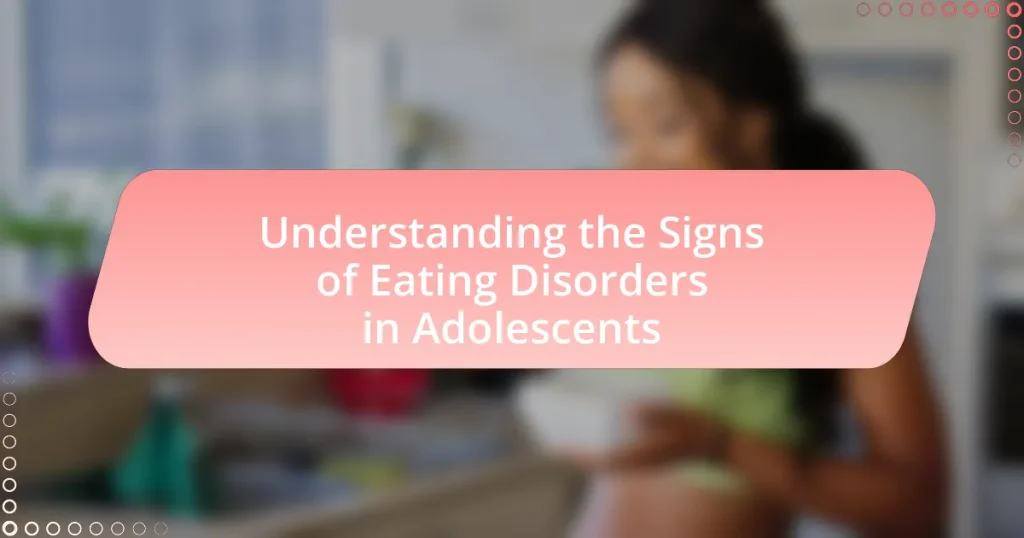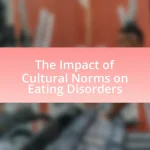Eating disorders in adolescents are serious mental health conditions that manifest through abnormal eating habits, significantly impacting physical and emotional health. Common types include anorexia nervosa, bulimia nervosa, and binge-eating disorder, each with distinct symptoms and behaviors. The article outlines how these disorders can present in adolescents, the importance of early recognition and intervention, and the potential consequences of untreated conditions. It also emphasizes the role of parents and caregivers in supporting adolescents, recognizing warning signs, and accessing professional help, while highlighting the benefits of early intervention and support groups in recovery.
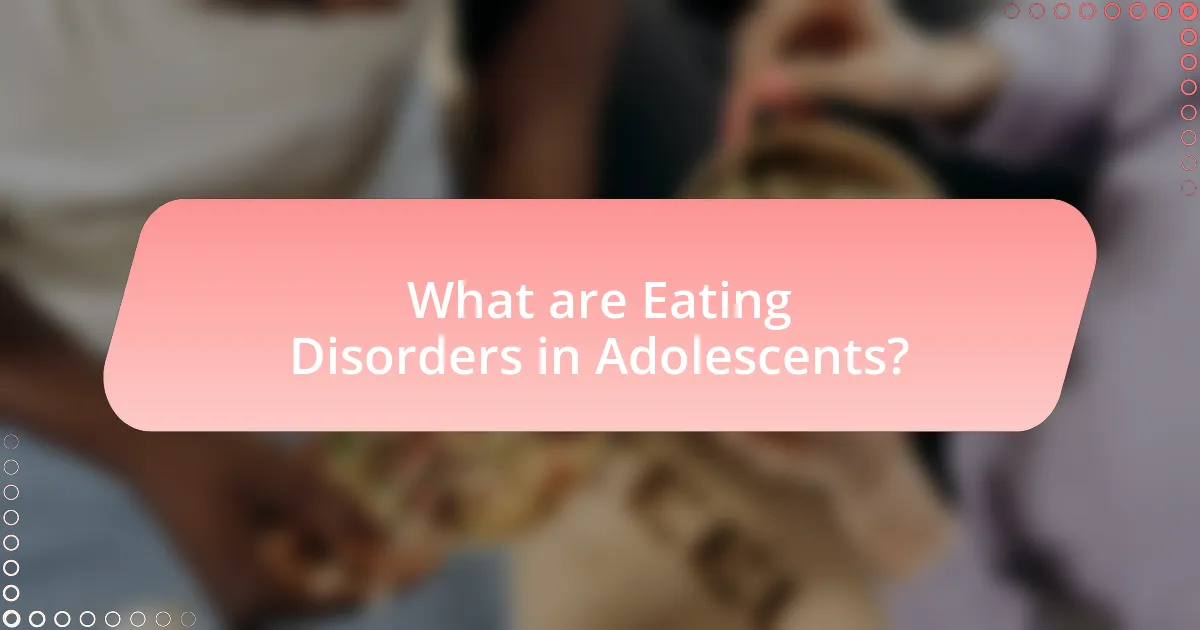
What are Eating Disorders in Adolescents?
Eating disorders in adolescents are serious mental health conditions characterized by abnormal eating habits that can negatively impact physical and emotional health. These disorders include anorexia nervosa, bulimia nervosa, and binge-eating disorder, each presenting distinct symptoms and behaviors. For instance, anorexia nervosa involves extreme restriction of food intake and an intense fear of gaining weight, while bulimia nervosa is marked by cycles of binge eating followed by purging. According to the National Eating Disorders Association, approximately 10% of adolescents experience an eating disorder, highlighting the prevalence and urgency of addressing these issues in this age group.
How do eating disorders manifest in adolescents?
Eating disorders in adolescents manifest through a range of behavioral, emotional, and physical symptoms. Common manifestations include significant weight loss or gain, preoccupation with food, body image distortion, and extreme dieting or exercise behaviors. Adolescents may also exhibit withdrawal from social activities, changes in mood, and signs of anxiety or depression. Research indicates that approximately 3% of adolescents experience eating disorders, with the onset often occurring during critical developmental periods, such as puberty. These disorders can lead to severe health complications, including malnutrition and psychological issues, underscoring the importance of early identification and intervention.
What are the common types of eating disorders seen in this age group?
The common types of eating disorders seen in adolescents include anorexia nervosa, bulimia nervosa, and binge eating disorder. Anorexia nervosa is characterized by extreme restriction of food intake and an intense fear of gaining weight, often leading to significant weight loss. Bulimia nervosa involves cycles of binge eating followed by compensatory behaviors such as vomiting or excessive exercise. Binge eating disorder is marked by recurrent episodes of eating large quantities of food without subsequent purging behaviors. According to the National Eating Disorders Association, these disorders often emerge during adolescence, a critical period for body image development and social pressures.
How do physical and emotional symptoms differ in adolescents?
Physical symptoms in adolescents primarily manifest as changes in body weight, nutritional deficiencies, and physical health issues, while emotional symptoms are characterized by mood swings, anxiety, and depression. For instance, adolescents with eating disorders may experience significant weight loss or gain, fatigue, and gastrointestinal problems as physical symptoms. In contrast, emotional symptoms may include feelings of worthlessness, social withdrawal, and heightened irritability, which are often linked to the psychological impact of body image issues. Research indicates that approximately 30% of adolescents with eating disorders also exhibit co-occurring mood disorders, highlighting the distinct yet interconnected nature of physical and emotional symptoms in this population.
Why is it important to recognize the signs early?
Recognizing the signs of eating disorders early is crucial because it allows for timely intervention, which can significantly improve recovery outcomes. Early detection can prevent the progression of the disorder, reducing the risk of severe health complications such as malnutrition, heart issues, and psychological distress. Research indicates that individuals who receive early treatment for eating disorders have a higher likelihood of full recovery, with studies showing that early intervention can lead to a 50% improvement in treatment success rates.
What are the potential consequences of untreated eating disorders?
Untreated eating disorders can lead to severe physical and psychological consequences. Physically, individuals may experience malnutrition, electrolyte imbalances, heart complications, and gastrointestinal issues, which can be life-threatening. For instance, studies indicate that anorexia nervosa has the highest mortality rate of any mental disorder, with approximately 10% of individuals dying from complications related to the disorder. Psychologically, untreated eating disorders can result in anxiety, depression, and social isolation, significantly impairing an individual’s quality of life. Research shows that early intervention can improve outcomes, highlighting the critical need for timely treatment.
How can early intervention improve outcomes for adolescents?
Early intervention can significantly improve outcomes for adolescents by addressing issues such as eating disorders at an early stage, which can lead to better recovery rates and overall mental health. Research indicates that adolescents who receive timely support and treatment for eating disorders are more likely to achieve full recovery compared to those who delay intervention. For instance, a study published in the Journal of Adolescent Health found that early treatment can reduce the duration and severity of eating disorders, leading to improved psychological well-being and social functioning. This evidence underscores the importance of recognizing and acting on the signs of eating disorders promptly to facilitate healthier developmental trajectories for adolescents.
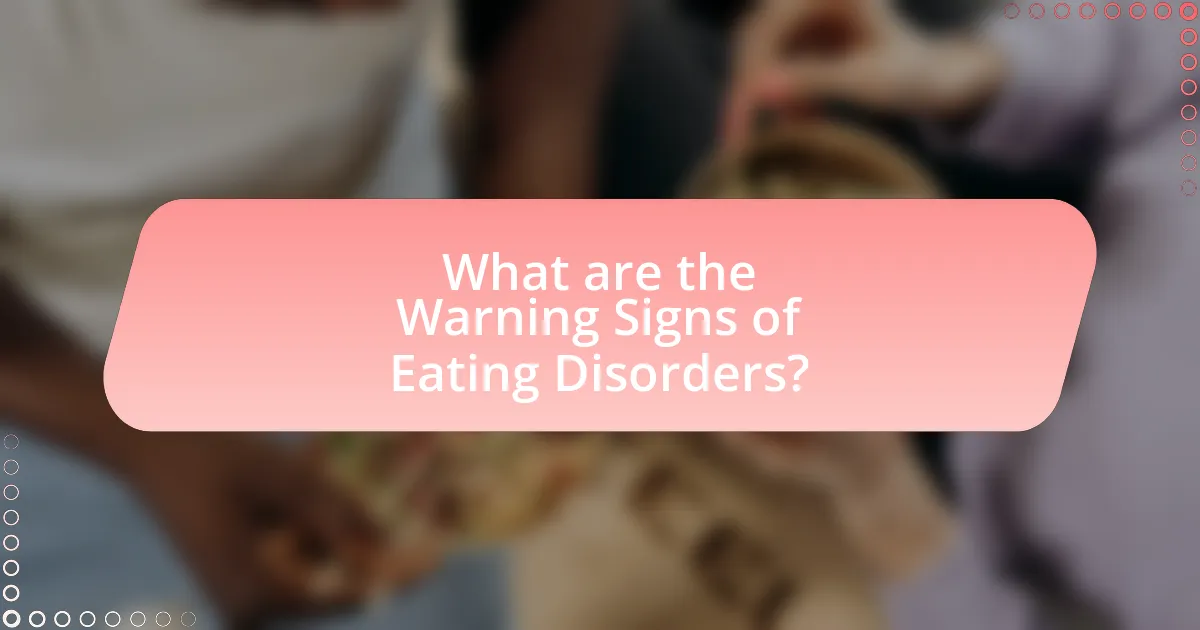
What are the Warning Signs of Eating Disorders?
Warning signs of eating disorders include drastic weight changes, preoccupation with food, body image issues, and avoidance of social situations involving food. Adolescents may exhibit behaviors such as skipping meals, excessive exercise, or using laxatives. Research indicates that approximately 30 million Americans will experience an eating disorder in their lifetime, highlighting the prevalence of these signs. Additionally, the National Eating Disorders Association notes that early intervention can significantly improve recovery outcomes, emphasizing the importance of recognizing these warning signs promptly.
What behavioral changes might indicate an eating disorder?
Behavioral changes that might indicate an eating disorder include significant alterations in eating habits, such as extreme restriction of food intake, binge eating, or purging behaviors. Adolescents may also exhibit obsessive thoughts about food, weight, and body image, leading to social withdrawal and avoidance of situations involving food. Additionally, changes in mood, such as increased irritability or anxiety, and a preoccupation with dieting or exercise can further signal the presence of an eating disorder. Research indicates that these behaviors often correlate with underlying psychological issues, making early identification crucial for effective intervention.
How can changes in eating habits signal a problem?
Changes in eating habits can signal a problem by indicating potential underlying issues such as emotional distress, nutritional deficiencies, or the onset of eating disorders. For instance, a significant increase or decrease in food intake, avoidance of certain food groups, or obsessive behaviors around food can reflect psychological conditions like anxiety or depression. Research shows that adolescents who exhibit drastic changes in their eating patterns are at a higher risk for developing eating disorders, with studies indicating that approximately 30% of adolescents with eating disorders report changes in their eating habits as a precursor to their condition.
What role does social withdrawal play in identifying eating disorders?
Social withdrawal serves as a significant indicator in identifying eating disorders, particularly among adolescents. When individuals begin to isolate themselves from social interactions, it often reflects underlying psychological distress, which is commonly associated with eating disorders such as anorexia nervosa and bulimia nervosa. Research indicates that approximately 50% of adolescents with eating disorders exhibit social withdrawal, highlighting its prevalence as a warning sign. This behavior can stem from feelings of shame, anxiety, or a desire to avoid situations that may trigger eating-related stress, further reinforcing the connection between social withdrawal and the presence of an eating disorder.
What physical signs should parents and caregivers look for?
Parents and caregivers should look for significant weight loss or fluctuations, changes in eating habits, and physical signs such as fatigue or dizziness. These indicators can suggest potential eating disorders in adolescents. For instance, a study published in the Journal of Adolescent Health found that adolescents with eating disorders often exhibit noticeable weight changes, which can be a critical sign for parents to monitor. Additionally, physical symptoms like hair loss, dry skin, or dental issues may also arise, further indicating the presence of an eating disorder.
How can changes in weight and appearance be indicators?
Changes in weight and appearance can indicate underlying issues such as eating disorders, mental health problems, or physical health conditions. For instance, significant weight loss or gain may signal anorexia, bulimia, or binge eating disorder, which are prevalent among adolescents. Research shows that adolescents with eating disorders often exhibit drastic changes in their physical appearance, including alterations in skin tone, hair health, and overall hygiene, which can further reflect their mental state. According to the National Eating Disorders Association, approximately 30 million Americans will struggle with an eating disorder in their lifetime, highlighting the importance of recognizing these indicators early for timely intervention.
What are the signs of nutritional deficiencies in adolescents?
Signs of nutritional deficiencies in adolescents include fatigue, poor concentration, and weakened immune function. Adolescents may also experience symptoms such as brittle hair and nails, delayed wound healing, and changes in mood or behavior. For instance, iron deficiency can lead to anemia, resulting in fatigue and weakness, while vitamin D deficiency may cause bone pain and muscle weakness. Additionally, inadequate intake of essential nutrients can manifest as skin issues, such as dryness or rashes, and dental problems, including cavities or gum disease. These signs indicate that adolescents may not be receiving the necessary nutrients for optimal growth and development.
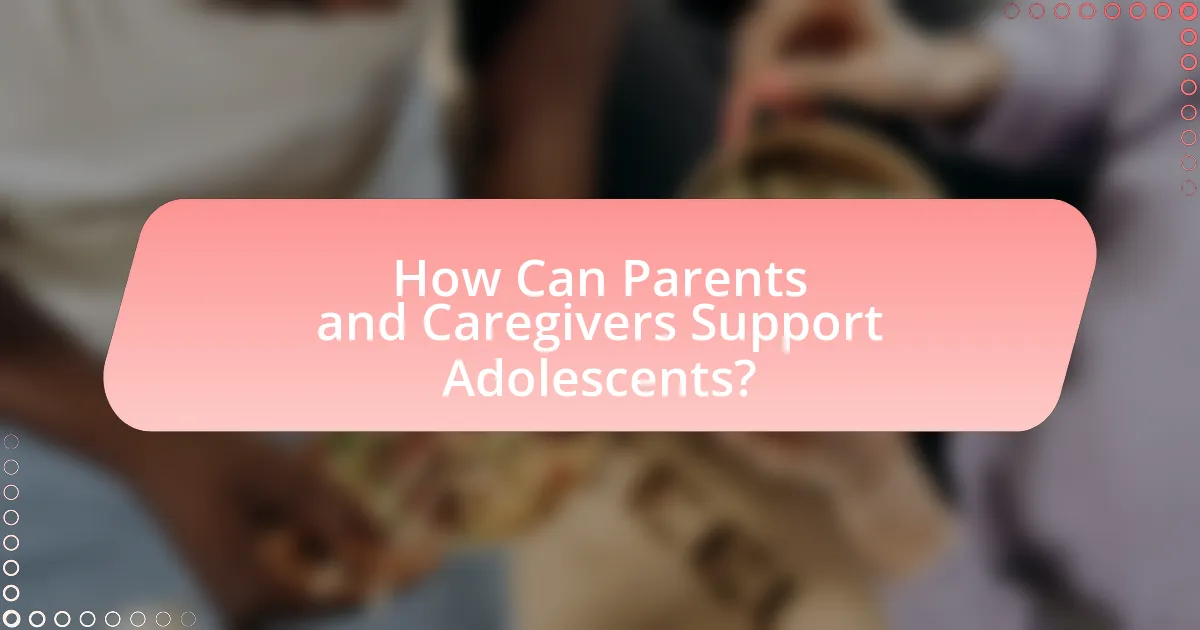
How Can Parents and Caregivers Support Adolescents?
Parents and caregivers can support adolescents by fostering open communication and creating a safe environment for discussing feelings and concerns. This approach encourages adolescents to express their thoughts about body image and eating habits, which is crucial in identifying potential eating disorders early. Research indicates that adolescents who feel supported by their parents are more likely to seek help when facing issues related to eating disorders, as highlighted in a study published in the Journal of Adolescent Health, which found that parental involvement significantly reduces the risk of developing such disorders. Additionally, parents can model healthy eating behaviors and promote a balanced lifestyle, reinforcing positive attitudes towards food and body image.
What strategies can be employed to foster open communication?
To foster open communication, establishing a safe and non-judgmental environment is essential. This can be achieved by actively listening to the individual, validating their feelings, and encouraging them to express their thoughts without fear of criticism. Research indicates that open dialogue can significantly improve emotional well-being, particularly in adolescents facing challenges such as eating disorders. For instance, a study published in the Journal of Adolescent Health found that supportive communication from parents and peers is linked to better mental health outcomes in adolescents.
How can parents create a supportive environment for discussing eating habits?
Parents can create a supportive environment for discussing eating habits by fostering open communication and modeling healthy behaviors. Encouraging regular family meals allows for discussions about food choices in a relaxed setting, promoting a sense of security. Research indicates that adolescents who engage in family meals are less likely to develop eating disorders, as these gatherings provide opportunities for parents to address concerns and reinforce positive eating habits. Additionally, parents should actively listen to their children’s feelings about food without judgment, which can help build trust and encourage honest conversations about eating habits.
What are effective ways to approach a conversation about concerns?
Effective ways to approach a conversation about concerns include using a calm and empathetic tone, actively listening, and expressing genuine care. Initiating the conversation in a private and comfortable setting helps create a safe space for open dialogue. Research indicates that using “I” statements, such as “I am worried about your health,” can reduce defensiveness and encourage a more constructive discussion. Additionally, being prepared with specific observations about behaviors or changes can provide clarity and context, making it easier for the other person to understand the concerns being raised.
What resources are available for families dealing with eating disorders?
Families dealing with eating disorders can access various resources, including support groups, educational materials, and professional treatment options. Organizations such as the National Eating Disorders Association (NEDA) provide helplines, online resources, and local support groups specifically designed for families. Additionally, the Academy for Eating Disorders offers educational resources and guidelines for families to understand and address eating disorders effectively. Research indicates that family involvement in treatment can significantly improve outcomes for individuals with eating disorders, highlighting the importance of these resources.
How can professional help be accessed for adolescents?
Professional help for adolescents can be accessed through various channels, including school counselors, mental health clinics, and pediatricians. School counselors provide immediate support and can refer students to specialized services, while mental health clinics offer therapy and treatment options specifically tailored for adolescents. Pediatricians can also assess and recommend mental health professionals, ensuring a comprehensive approach to care. According to the National Institute of Mental Health, early intervention is crucial for effective treatment of eating disorders, highlighting the importance of accessing professional help promptly.
What role do support groups play in recovery?
Support groups play a crucial role in recovery by providing emotional support, shared experiences, and accountability among individuals facing similar challenges. These groups foster a sense of community, which can significantly reduce feelings of isolation often experienced by those recovering from eating disorders. Research indicates that participation in support groups can lead to improved psychological well-being and increased motivation to adhere to treatment plans. For instance, a study published in the Journal of Eating Disorders found that individuals who engaged in support groups reported higher levels of recovery and lower rates of relapse compared to those who did not participate.
What are some practical tips for recognizing and addressing eating disorders?
Practical tips for recognizing and addressing eating disorders include observing significant changes in eating habits, weight fluctuations, and emotional distress related to food. For instance, adolescents may exhibit extreme dieting, binge eating, or avoidance of certain food groups, which can indicate an underlying disorder. Additionally, monitoring behaviors such as excessive exercise or withdrawal from social activities can provide further insight into their mental state.
Addressing these issues involves open communication, expressing concern without judgment, and encouraging professional help. Research indicates that early intervention can significantly improve recovery outcomes, as noted in a study published in the Journal of Adolescent Health, which emphasizes the importance of timely support and treatment.
